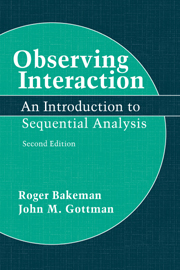Book contents
- Frontmatter
- Contents
- Preface to the second edition
- Preface to the first edition
- 1 Introduction
- 2 Developing a coding scheme
- 3 Recording behavioral sequences
- 4 Assessing observer agreement
- 5 Representing observational data
- 6 Analyzing sequential data: First steps
- 7 Analyzing event sequences
- 8 Issues in sequential analysis
- 9 Analyzing time sequences
- 10 Analyzing cross-classified events
- 11 Epilogue
- Appendix: A Pascal program to compute kappa and weighted kappa
- References
- Index
2 - Developing a coding scheme
Published online by Cambridge University Press: 13 October 2009
- Frontmatter
- Contents
- Preface to the second edition
- Preface to the first edition
- 1 Introduction
- 2 Developing a coding scheme
- 3 Recording behavioral sequences
- 4 Assessing observer agreement
- 5 Representing observational data
- 6 Analyzing sequential data: First steps
- 7 Analyzing event sequences
- 8 Issues in sequential analysis
- 9 Analyzing time sequences
- 10 Analyzing cross-classified events
- 11 Epilogue
- Appendix: A Pascal program to compute kappa and weighted kappa
- References
- Index
Summary
Introduction
The first step in observational research is developing a coding scheme. It is a step that deserves a good deal of time and attention. Put simply, the success of observational studies depends on those distinctions that early on become enshrined in the coding scheme. Later on, it will be the job of observers to note when the behaviors defined in the code catalog occur in the stream of behavior. What the investigator is saying, in effect, is: This is what I think important; this is what I want extracted from the passing stream. Yet sometimes the development of coding schemes is approached almost casually, and so we sometimes hear people ask: Do you have a coding scheme I can borrow? This seems to us a little like wearing someone else's underwear. Developing a coding scheme is very much a theoretical act, one that should begin in the privacy of one's own study, and the coding scheme itself represents an hypothesis, even if it is rarely treated as such. After all, it embodies the behaviors and distinctions that the investigator thinks important for exploring the problem at hand. It is, very simply, the lens with which he or she has chosen to view the world.
Now if that lens is thoughtfully constructed and well formed (and aimed in the right direction), a clearer view of the world should emerge. But if not, no amount of corrective action will bring things into focus later. That is, no amount of technical virtuosity, no mathematical geniuses or statistical saviors, can wrest understanding from ill-conceived or wrong-headed coding schemes.
Information
- Type
- Chapter
- Information
- Observing InteractionAn Introduction to Sequential Analysis, pp. 15 - 37Publisher: Cambridge University PressPrint publication year: 1997
Accessibility standard: Unknown
Why this information is here
This section outlines the accessibility features of this content - including support for screen readers, full keyboard navigation and high-contrast display options. This may not be relevant for you.Accessibility Information
- 2
- Cited by
